Day 0
Night View from Hari's balcony
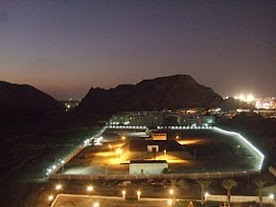 When our plane from Mumbai took to air about 30 minutes after it was supposed to, I wondered if we were going to further inconvenience Hari and Veena since even our scheduled time of arrival at Muscat was as late as 11:15 PM! Someone must have sensed my concern, for not only did the pilot make up most of the lost time, but the whole process of immigration, and getting our bags went breezily and we were out of the airport before midnight. The moment we came out, we saw two friendly faces and four hands waving at us vigorously! Hari and Veena led us to their Merc, whose trunk seemed custom-made to fit our luggage! The drive home itself was quite an experience, especially for Atish and me, who were visiting the Middle East for the first time. Not only was the car ride smooth, Muscati roads were just awesome! The first thing to impress us about Muscat was its infrastructure. As we drove along, Hari and Veena pointed out buildings of interest. We noticed that all buildings were shades of cream, beige, and ecru. They were far from drab though, for the archetypal Islamic architecture added elegance of the subdued colors. Most striking among the buildings was the grand royal opera house, which stood stylishly graceful with its sophisticated lighting. The current sultan, Qaboos Bin Said, who is an avid fan of classical music and the arts, had this built recently and it opened just a few months ago. In less than half an hour, we reached Hari’s lovely and spacious seventh floor apartment in a modern complex called Hatat. The view from the balcony with the half-moon lit sky was quite remarkable. Despite the late hour, we sat and chatted a bit about various things including the plan for the next day. This, of course, was done over a cup of tea. (From now on, I shall refrain from mentioning the numerous times that we downed cups of tea since that will become the largest section of this write-up!)
When our plane from Mumbai took to air about 30 minutes after it was supposed to, I wondered if we were going to further inconvenience Hari and Veena since even our scheduled time of arrival at Muscat was as late as 11:15 PM! Someone must have sensed my concern, for not only did the pilot make up most of the lost time, but the whole process of immigration, and getting our bags went breezily and we were out of the airport before midnight. The moment we came out, we saw two friendly faces and four hands waving at us vigorously! Hari and Veena led us to their Merc, whose trunk seemed custom-made to fit our luggage! The drive home itself was quite an experience, especially for Atish and me, who were visiting the Middle East for the first time. Not only was the car ride smooth, Muscati roads were just awesome! The first thing to impress us about Muscat was its infrastructure. As we drove along, Hari and Veena pointed out buildings of interest. We noticed that all buildings were shades of cream, beige, and ecru. They were far from drab though, for the archetypal Islamic architecture added elegance of the subdued colors. Most striking among the buildings was the grand royal opera house, which stood stylishly graceful with its sophisticated lighting. The current sultan, Qaboos Bin Said, who is an avid fan of classical music and the arts, had this built recently and it opened just a few months ago. In less than half an hour, we reached Hari’s lovely and spacious seventh floor apartment in a modern complex called Hatat. The view from the balcony with the half-moon lit sky was quite remarkable. Despite the late hour, we sat and chatted a bit about various things including the plan for the next day. This, of course, was done over a cup of tea. (From now on, I shall refrain from mentioning the numerous times that we downed cups of tea since that will become the largest section of this write-up!)
Day 1 – Wednesday, Feb. 1
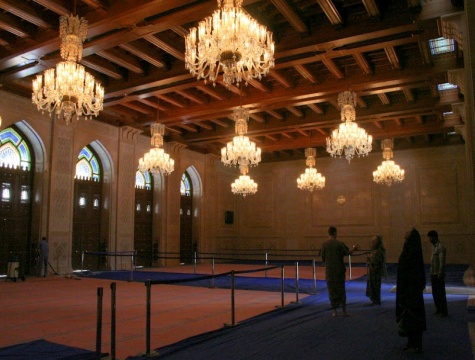
 Early next morning, after a continental breakfast, Hari left for work. The plan was for Veena, Atish, and me to go to the Sultan Qaboos grand mosque in Ruwi that morning in Shauqat’s taxi. After Veena’s friendly domestic help Padmini made lunch for us, we got ready. Under Veena’s guidance, I made sure I was dressed from head to toe in a black salwar kameez. With the duppatta over my head, I looked like a veritable Muscati Muslim. Or so I thought……..
Early next morning, after a continental breakfast, Hari left for work. The plan was for Veena, Atish, and me to go to the Sultan Qaboos grand mosque in Ruwi that morning in Shauqat’s taxi. After Veena’s friendly domestic help Padmini made lunch for us, we got ready. Under Veena’s guidance, I made sure I was dressed from head to toe in a black salwar kameez. With the duppatta over my head, I looked like a veritable Muscati Muslim. Or so I thought……..
Our cabbie Shauqat turned out to be a Bangladeshi settled in Oman for over 20 years. So, we felt quite at home. We were impressed by his manner of speaking as well as content. He pointed out interesting sights to us, with a commentary on each place. He first drove us to the mosque, which was open to non-Muslims only Mondays to Thursdays until 11 AM.

 The sprawling sandstone mosque that was gleaming in the morning sunlight was a sight to behold! It was magnificent! It was a grand example of beautiful Islamic architecture. The dome, the main minaret, and the four surrounding minarets stood imposingly before us. As we entered the gate, I covered my head and my arms with my duppatta; but was stopped by the gatekeepers who said that they could see the elbow portion of my arms! They seemed pretty well trained in spotting skin on women! They asked Veena and me to go to the store (in the mosque premises) to buy a full sleeved T-shirt that would fully cover our arms! As expected, they cost 5 Omani riyals (about $13) each! We grumblingly wore those T shirts over our salwar kameezes and entered the mosque looking like clowns! The striped design on the T-shirt added to the effect! BUT, were we in for a treat! The prayer hall which was immense and could accommodate thousands of worshippers was adorned by the largest hand woven carpet in the world. The pièce(s) de résistance were the chandeliers. There were several large opulent, yet elegant chandeliers lighting up the place. I have never seen chandeliers with crafted so artfully with such detail, using sparkling crystals and gold. Despite the size, they did not look garish. They looked like a piece of art. Because of the light from the chandeliers, the photographs, unfortunately, do not do justice to the fine work on the chandeliers. With Veena and Shauqat’s guidance, we toured the mosque in its entirety. The manner in which the Muscatis have maintained the mosque and the beautiful flower garden outside was truly commendable. Were we glad that we were Muscat on a day that the mosque was open! We would not have wanted to miss experiencing this fine monument.
The sprawling sandstone mosque that was gleaming in the morning sunlight was a sight to behold! It was magnificent! It was a grand example of beautiful Islamic architecture. The dome, the main minaret, and the four surrounding minarets stood imposingly before us. As we entered the gate, I covered my head and my arms with my duppatta; but was stopped by the gatekeepers who said that they could see the elbow portion of my arms! They seemed pretty well trained in spotting skin on women! They asked Veena and me to go to the store (in the mosque premises) to buy a full sleeved T-shirt that would fully cover our arms! As expected, they cost 5 Omani riyals (about $13) each! We grumblingly wore those T shirts over our salwar kameezes and entered the mosque looking like clowns! The striped design on the T-shirt added to the effect! BUT, were we in for a treat! The prayer hall which was immense and could accommodate thousands of worshippers was adorned by the largest hand woven carpet in the world. The pièce(s) de résistance were the chandeliers. There were several large opulent, yet elegant chandeliers lighting up the place. I have never seen chandeliers with crafted so artfully with such detail, using sparkling crystals and gold. Despite the size, they did not look garish. They looked like a piece of art. Because of the light from the chandeliers, the photographs, unfortunately, do not do justice to the fine work on the chandeliers. With Veena and Shauqat’s guidance, we toured the mosque in its entirety. The manner in which the Muscatis have maintained the mosque and the beautiful flower garden outside was truly commendable. Were we glad that we were Muscat on a day that the mosque was open! We would not have wanted to miss experiencing this fine monument.
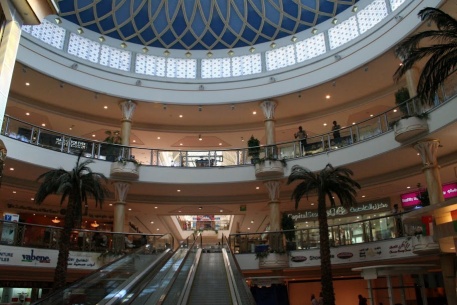
When we hit the road after seeing the mosque, Shauqat was very keen on showing us a Muscat shopping mall, saying it is quite different from the malls in the west. He drove us on beautiful six-lane express ways, which once again impressed us. As we entered the Markaz Al Bahja mall, Shauqat gleefully pointed to two beautifully carved huge doors at the entrance of the mall and said “You might have seen malls in the US; but have you seen ones with such beautiful doors?” Actually, we have not! The mall inside had ethnic and exotic wares; but was otherwise like any western mall. Most of the shops were on the main floor. There were cinema halls, kids’ amusement area, food places etc. on the first floor.

 After our window shopping, Shauqat took us on a ride around the coastal districts of Muscat Al Qurum Heights, Al Khuwair and Al Seeb. The roads were beautifully paved, traffic much less than what one sees on rte 66(!) and the sights were beautiful. We passed by the consulate area, which like any other city, had posh buildings in a good locality. He then took us to a place called the “Wave”, where the Omanis are building an upscale neighborhood by the sea, with homes costing at least a million dollars. It is prime real estate with all amenities. It is still under construction and a large new airport is also being built right opposite the Wave. Wave is one place where foreigners can buy homes and perhaps for this reason, the Omanis want to make sure that the airport is easily accessible.
After our window shopping, Shauqat took us on a ride around the coastal districts of Muscat Al Qurum Heights, Al Khuwair and Al Seeb. The roads were beautifully paved, traffic much less than what one sees on rte 66(!) and the sights were beautiful. We passed by the consulate area, which like any other city, had posh buildings in a good locality. He then took us to a place called the “Wave”, where the Omanis are building an upscale neighborhood by the sea, with homes costing at least a million dollars. It is prime real estate with all amenities. It is still under construction and a large new airport is also being built right opposite the Wave. Wave is one place where foreigners can buy homes and perhaps for this reason, the Omanis want to make sure that the airport is easily accessible.
On our way back from the Wave, we stopped by at the hospital as planned; but found out that Hari was locked in an emergency surgery and would not be able to come home with us. After meeting some of Hari’s colleagues, we headed home to have Veena’s world famous udipi style race kuzhambu and avaraikkai curry for lunch (with Hari, who joined us after some time).
After lunch, we sat around and “adda maaroed” – a la typical Bengali style! It was fun to see Atish and Hari bonding. At this time, Hari also gave us a primer on laparoscopy. He said he could have shown us a real laparoscopic surgery in action; but he had taken leave while we were there and hence had not scheduled any surgery :-). He promised us the next best thing, which was to do a dry run with all the laparoscopic instruments. He straight away called his hospital staff and asked them to put aside some instruments so he could bring them home for a demo! He then went to the hospital to check on a couple of patients while we took a short snooze.
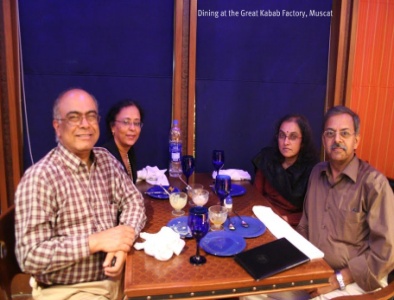
 At night, Hari took us to The Great Kabab Factory, a restaurant which Hari had shortlisted for us. The food was great and more than plenty and they served us all the food lovingly. (Perhaps, because they remembered Hari-Veena’s pretty daughter Jotika from their last visit to the restaurant!) We came home more than sated. I think I ate more than I had done in a long time! Oh! One interesting observation! A drink called laban is quite popular in Oman. It is very close to our neer-mor or the Bengali ghol. (Incidentally laban means salt in bangla. Wonder if that played into the etymology of the drink’s name.)
At night, Hari took us to The Great Kabab Factory, a restaurant which Hari had shortlisted for us. The food was great and more than plenty and they served us all the food lovingly. (Perhaps, because they remembered Hari-Veena’s pretty daughter Jotika from their last visit to the restaurant!) We came home more than sated. I think I ate more than I had done in a long time! Oh! One interesting observation! A drink called laban is quite popular in Oman. It is very close to our neer-mor or the Bengali ghol. (Incidentally laban means salt in bangla. Wonder if that played into the etymology of the drink’s name.)
Day 2 – Thursday, Feb. 2
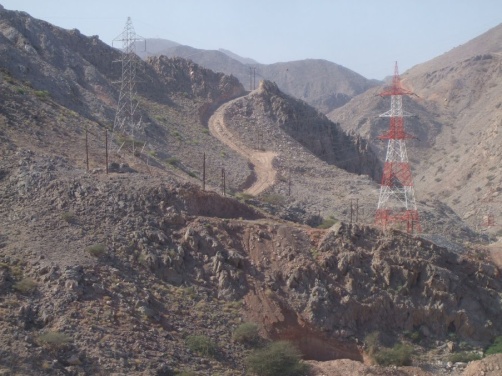 The next morning was a beautiful, bright sunny morning. I started the day with soaking in the view from Hari-Veena’s apartment balcony. It was interesting to see a water truck sprinkling water over mounds of soil. Veena explained that they dig out the mud for construction and that causes a lot of dust in homes around. To reduce the dust, they sprinkle water all over the mounds. My first reaction was “wow! How much water they must be wasting; but soon the realization came hat it was probably sea water. In this context, one notable observation we made was that despite limited rainfall in Oman, there seemed to be no water shortage. Desalination and judicious conservation of water resources were perhaps the key? Once again, this speaks well of the current Sultan of Oman, who seems to have a good vision for the country’s future.
The next morning was a beautiful, bright sunny morning. I started the day with soaking in the view from Hari-Veena’s apartment balcony. It was interesting to see a water truck sprinkling water over mounds of soil. Veena explained that they dig out the mud for construction and that causes a lot of dust in homes around. To reduce the dust, they sprinkle water all over the mounds. My first reaction was “wow! How much water they must be wasting; but soon the realization came hat it was probably sea water. In this context, one notable observation we made was that despite limited rainfall in Oman, there seemed to be no water shortage. Desalination and judicious conservation of water resources were perhaps the key? Once again, this speaks well of the current Sultan of Oman, who seems to have a good vision for the country’s future.
 After our usual breakfast, we set out to see the ethnic markets called souqs in Ruwi, the old commercial area of Muscat. The souq is located by the sea and in a basin formed by the mountains. On the way, Hari also pointed out a couple of medieval gates around old Muscat and told us that these gates were locked at sunset in the olden days and those who tried to cross it were put in a dungeon!
After our usual breakfast, we set out to see the ethnic markets called souqs in Ruwi, the old commercial area of Muscat. The souq is located by the sea and in a basin formed by the mountains. On the way, Hari also pointed out a couple of medieval gates around old Muscat and told us that these gates were locked at sunset in the olden days and those who tried to cross it were put in a dungeon!

 A couple of cruise ships had docked there that morning and the place was abuzz! The market reminded me a lot of Jan path in Delhi. Many of the shopkeepers were desis too! Shopping here was quite an interesting experience, which gave us a good flavor of Oman. The wares were mostly ethnic and part of the fun in shopping was the bargaining without knowing the language! Finally, we landed in a shop where we found several items of interest. Two things worked in our favor. First, as soon as we entered, the shopkeeper recognized Hari as the doctor who treated his son at KIMS Oman recently! Hari - a celebrity! Then, Atish’s keen ears caught wind of the fact that the shopkeepers were talking bangla among themselves! They were Bangladeshis settled in Oman for many years. That made the bargaining a bit easier! I am not sure if we got the best deals; but we felt happy that we did!
A couple of cruise ships had docked there that morning and the place was abuzz! The market reminded me a lot of Jan path in Delhi. Many of the shopkeepers were desis too! Shopping here was quite an interesting experience, which gave us a good flavor of Oman. The wares were mostly ethnic and part of the fun in shopping was the bargaining without knowing the language! Finally, we landed in a shop where we found several items of interest. Two things worked in our favor. First, as soon as we entered, the shopkeeper recognized Hari as the doctor who treated his son at KIMS Oman recently! Hari - a celebrity! Then, Atish’s keen ears caught wind of the fact that the shopkeepers were talking bangla among themselves! They were Bangladeshis settled in Oman for many years. That made the bargaining a bit easier! I am not sure if we got the best deals; but we felt happy that we did!
After a brief visit to KIMS hospital, we came home as happy campers. We had Veena’s delicious patrodais, another udipi(?) creation, for lunch. While Hari had planned out places for us to visit, Veena seemed to have carefully planned what gastronomical specialties we should have during our stay! Atish and I had a cool experience of watching Hari demonstrate a laparoscopic surgery using various laparoscopic instruments. He did this while explaining lucidly what each instrument was meant, while also giving us a bit of history of each instrument. Though we had read and heard about laparoscopy, having this demo was fascinating and valuable in a better understanding the surgery process.
We all then got ready for the main event of the day – a musical evening with Hari-Veena’s musically gifted friends. It was a truly enjoyable evening for their friends were not only musically gifted, but also very warm and affectionate. One was a relative of our own Nanu and his family is like the Van Trapps'! All of them sing mellifluously. His wife, is a popular carnatic music teacher in Muscat, had recently performed at a Chennai sabha during the December music season. I had a pretty sore throat, perhaps due to an overdose of laban the previous night? But, I could not stay away from singing because Hari had so enthusiastically planned and arranged for this evening. (Afterthought upon hearing the recordings is that perhaps, I should have listened instead of sing!) Hari and Veena had also arranged a delectable dinner. So, both our ears and tummies were smiling after their respective feasts!
Day 2 – Friday, Feb. 3
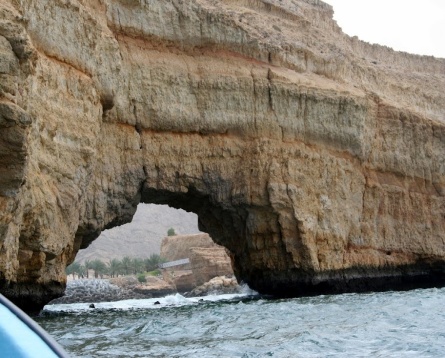
 The next morning, we set out to the Al Qantab beach. The drive itself was rather scenic. One gets impressed by how green the place is, despite being a desert. Hari told us that this was not the case during his previous stint in Muscat over 25 years ago.
The next morning, we set out to the Al Qantab beach. The drive itself was rather scenic. One gets impressed by how green the place is, despite being a desert. Hari told us that this was not the case during his previous stint in Muscat over 25 years ago.
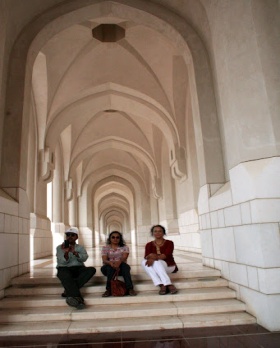
At Al Qantab, a poor elderly fisherman with the sweetest smile on a human countenance, took us on a motor boat ride along the rocky formations in the sea. The formations were rather impressive! Our boat weaved through the holes in the rock formation, which was pretty cool! The rocky coastline and the striking color of the rock formations made the whole experience quite memorable. On the beach is the famous and luxurious Shangri-La's Resort and Spa. Some of the architecture of the hotel is inspired by old Muscat, with buildings of varying heights and fancy balconies.

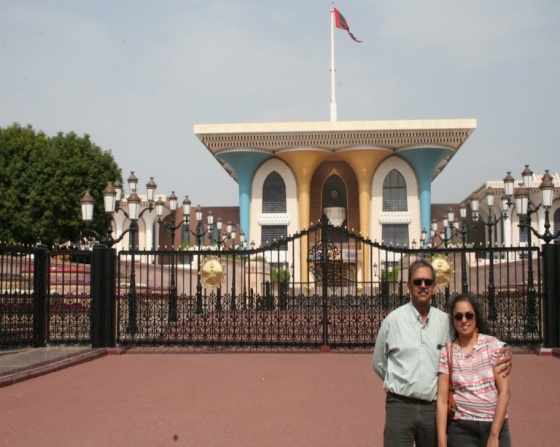
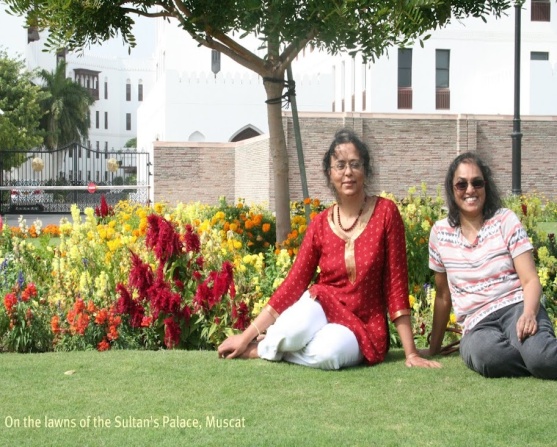
 From there, we drove on quite a picturesque route to the Sultan’s majestic palace. The architecture was unique and different from any other palace I have seen. It is in this palace that the current sultan staged a bloodless coup with the help of the British, and took over the rule from his father. The current sultan is hailed as a visionary and is liked by the masses. The United Nations naming Oman as the most-improved nation during in the last 40 years, bears testament to his vision.
From there, we drove on quite a picturesque route to the Sultan’s majestic palace. The architecture was unique and different from any other palace I have seen. It is in this palace that the current sultan staged a bloodless coup with the help of the British, and took over the rule from his father. The current sultan is hailed as a visionary and is liked by the masses. The United Nations naming Oman as the most-improved nation during in the last 40 years, bears testament to his vision.
On our way back, ravenous as we were, we stopped by at Kamat’s restaurant and had a satisfying meal of vegetarian thali.
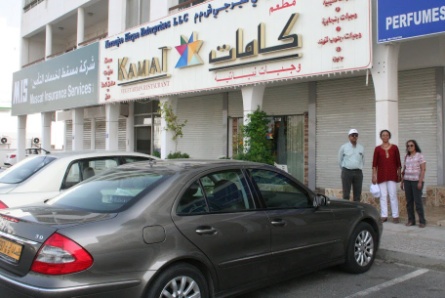 We reached home at about 4:30 PM and caught up on some more gupshup and oh yes, some more tea(!). After a short nap, we packed all our stuff, had a quick dinner and set out for the airport, feeling a bit sullen at the thought of having to say goodbye.
We reached home at about 4:30 PM and caught up on some more gupshup and oh yes, some more tea(!). After a short nap, we packed all our stuff, had a quick dinner and set out for the airport, feeling a bit sullen at the thought of having to say goodbye.
All in all, our trip to Muscat was made special and memorable by our dear friends Hari and Veena. Hari managed to take utmost care of us as well as visiting the hospital to see his patients with great aplomb. God bless Hari and Veena!